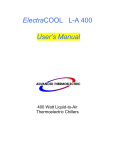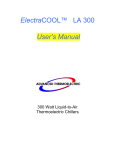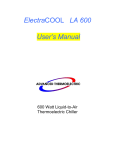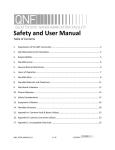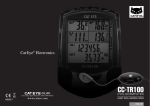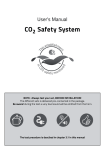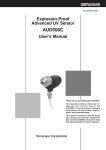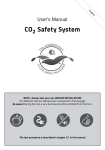Download Model 3007 Condensation Particle Counter Operation and Service
Transcript
Particle Instruments Model 3007 Condensation Particle Counter Operation and Service Manual 1930035, Revision C August 2002 Model 3007 Condensation Particle Counter Operation and Service Manual 1930035, Revision C August 2002 U.S. Sales and Customer Service: 1-(800) 874-2811 USA/ 001-(651) 490-2811 Fax: 001-(651) 490-3824 MAIL TO: TSI Incorporated 500 Cardigan Road Shoreview, MN 55126-3996 USA E-mail address: [email protected] Website: http://www.tsi.com Copyright © TSI Incorporated / Revision C / 1999–2002 / All rights reserved. Address TSI Incorporated / 500 Cardigan Road / Shoreview, MN 55126 / USA Fax No. (651) 490-3824 LIMITATION OF WARRANTY AND LIABILITY (effective July 2000) Seller warrants the goods sold hereunder, under normal use and service as described in the operator's manual, shall be free from defects in workmanship and material for twenty-four (24) months, or the length of time specified in the operator's manual, from the date of shipment to the customer. This warranty period is inclusive of any statutory warranty. This limited warranty is subject to the following exclusions: a. Hot-wire or hot-film sensors used with research anemometers, and certain other components when indicated in specifications, are warranted for 90 days from the date of shipment. b. Parts repaired or replaced as a result of repair services are warranted to be free from defects in workmanship and material, under normal use, for 90 days from the date of shipment. c. Seller does not provide any warranty on finished goods manufactured by others or on any fuses, batteries or other consumable materials. Only the original manufacturer's warranty applies. d. Unless specifically authorized in a separate writing by Seller, Seller makes no warranty with respect to, and shall have no liability in connection with, goods which are incorporated into other products or equipment, or which are modified by any person other than Seller. The foregoing is IN LIEU OF all other warranties and is subject to the LIMITATIONS stated herein. NO OTHER EXPRESS OR IMPLIED WARRANTY OF FITNESS FOR PARTICULAR PURPOSE OR MERCHANTABILITY IS MADE. TO THE EXTENT PERMITTED BY LAW, THE EXCLUSIVE REMEDY OF THE USER OR BUYER, AND THE LIMIT OF SELLER'S LIABILITY FOR ANY AND ALL LOSSES, INJURIES, OR DAMAGES CONCERNING THE GOODS (INCLUDING CLAIMS BASED ON CONTRACT, NEGLIGENCE, TORT, STRICT LIABILITY OR OTHERWISE) SHALL BE THE RETURN OF GOODS TO SELLER AND THE REFUND OF THE PURCHASE PRICE, OR, AT THE OPTION OF SELLER, THE REPAIR OR REPLACEMENT OF THE GOODS. IN NO EVENT SHALL SELLER BE LIABLE FOR ANY SPECIAL, CONSEQUENTIAL OR INCIDENTAL DAMAGES. SELLER SHALL NOT BE RESPONSIBLE FOR INSTALLATION, DISMANTLING OR REINSTALLATION COSTS OR CHARGES. No Action, regardless of form, may be brought against Seller more than 12 months after a cause of action has accrued. The goods returned under warranty to Seller's factory shall be at Buyer's risk of loss, and will be returned, if at all, at Seller's risk of loss. Buyer and all users are deemed to have accepted this LIMITATION OF WARRANTY AND LIABILITY, which contains the complete and exclusive limited warranty of Seller. This LIMITATION OF WARRANTY AND LIABILITY may not be amended, modified or its terms waived, except by writing signed by an Officer of Seller. Service Policy Knowing that inoperative or defective instruments are as detrimental to TSI as they are to our customers, our service policy is designed to give prompt attention to any problems. If any malfunction is discovered, please contact your nearest sales office or representative, or call TSI's Customer Service department at 1-800-874-2811 (USA) or (651) 490-2811. ii CONTENTS SAFETY INFORMATION............................................................................V 1. UNPACKING AND PARTS IDENTIFICATION ..................................1 Unpacking the Condensation Particle Counter ........................................1 Spare/Replacement Parts..........................................................................4 2. SETTING UP...........................................................................................5 Supplying Power to the Instrument..........................................................5 Installing the Batteries..........................................................................5 Using the AC Adapter ..........................................................................6 Charging and Installing the Alcohol Wick ..............................................7 Cautions Before Proceeding.................................................................7 Locating and Identifying Components .................................................7 Filling the Alcohol Fill Capsule ...........................................................8 Installing the Cartridge into the Condensation Particle Counter ........10 Cleaning Up and Final Cautions ........................................................11 3. OPERATION.........................................................................................13 Overview................................................................................................13 Turning the Instrument On.....................................................................13 Tilting the Instrument ............................................................................13 Daily Zero Check...................................................................................15 Keypad ...................................................................................................15 Main Menu.............................................................................................16 Particle Concentration ........................................................................16 Absolute Pressure ...............................................................................16 Setup Mode ........................................................................................17 Statistics ........................................................................................17 Logged Test Statistics ...............................................................18 Log Interval...................................................................................18 Audio.............................................................................................19 Time/Date......................................................................................20 Backlight .......................................................................................21 Clear Memory ...............................................................................21 LOG MODE.......................................................................................22 Log Mode 2 and 3..................................................................................22 Memory Considerations.........................................................................24 4. MAINTENANCE ..................................................................................25 Maintenance Schedule ...........................................................................25 Daily Zero Check...................................................................................25 Recharging the Alcohol Wick................................................................26 iii Alcohol Cartridge .................................................................................. 26 Changing the Alcohol Wick............................................................... 26 Removing the Wick from the Cartridge............................................. 27 Re-assembling the Alcohol Cartridge ................................................ 28 5. TROUBLESHOOTING ........................................................................ 31 APPENDIXES A. SPECIFICATIONS ............................................................................... 35 B. MODEL 3007 FLOW SCHEMATIC.................................................... 37 C. MATERIAL SAFETY DATA SHEET: ISOPROPYL ALCOHOL ..... 39 iv Contents Safety Information When operated according to the manufacturer’s instruction, this device is a Class I laser product as defined by U.S. Department of Health and Human Services standards under the Radiation Control for Health and Safety Act of 1968. A certification and identification label like the one shown below is affixed to each instrument. August, 1998 THIS LASER PRODUCT COMFORMS TO 21 CFR 1040.10 BUREAU OF RADIOLOGICAL HEALTH AND SAFETY REGULATIONS. There are no user-serviceable parts inside this instrument. Performing services other than those described in this manual may result in exposure to harmful (invisible) laser radiation. A warning label like the one shown below is affixed to the internal laser device. DANGER: INVISIBLE LASER RADIATION WHEN OPEN. AVOID DIRECT EXPOSURE TO BEAM. WARNING: NO USER SERVICEABLE PARTS INSIDE. REFER SERVICING TO QUALIFIED PERSONNEL. v vi Safety Information Chapter 1 Unpacking and Parts Identification Unpacking the Condensation Particle Counter Carefully unpack the Model 3007 Condensation Particle Counter (CPC) from the shipping container. Use the tables and illustrations below to make certain that there are no missing components. Contact TSI immediately if anything is missing or damaged. 1 3 2 4 Figure 1-1: Model 3007 Condensation Particle Counter With Inlet Probe Assembly, Battery Pack, and Batteries Quantity 1 1 1 6 1 Item Description Condensation Particle Counter Aerosol Inlet Fitting (installed) Battery holder Battery, AA, alkaline Carrying case Part/Model N/A N/A 801623 N/A 801613 Reference 1 2 3 4 (not shown) 1 2 1 3 Figure 1-2: Alcohol Fill Capsule with Storage Cap, Alcohol Cartridge, Alcohol Bottles and Shoulder Strap Quantity 1 1 16 2 Item Description Alcohol fill capsule and storage cap. Alcohol cartridge 30 ml alcohol bottles (1 shown) Part/Model 1083070 Reference 1 801624 2918011 2 3 Chapter 1 2 3 4 1 Figure 1-3: Mesh Storage Bag with Spare Wicks, Computer Cable, Zero Filters and DB9/DB25 Adapter Quantity 1 2 1 1 Item Description Mesh bag Spare wick kit Computer cable, RJ45/DB9 HEPA zero filter, with adapter Unpacking and Parts Identification Part/Model 1380031 1081479 800563 1030314 Reference 1 2 3 4 3 3 2 1 Figure 1-4: Calibration Certificate, Operation and Service Manual, Aerosol Instrument Manager® Software Quantity 1 1 1 Item Description Calibration Certificate Aerosol Instrument Manager® Software Operation and Service Manual Part/Model N/A N/A Reference 1 2 1930035 3 Spare/Replacement Parts The following items may be purchased as spare or replacement parts. Item Description Alcohol wicks with screens (Pkg. of 10) Filter, internal, 2 qty. Alcohol, 16 qty., 30 ml bottles 4 Part Number 8023 801614 2918011 Chapter 1 Chapter 2 Setting Up Supplying Power to the Instrument The Model 3007 Condensation Particle Counter (CPC) may be powered in one of two ways. The standard configuration instrument is sold with a battery holder containing 6, AA alkaline batteries and an AC adapter to power the instrument when operating in a fixed location. Installing the Batteries To install the battery holder, first install the 6 individual AA batteries into the pack, noting the battery polarity as marked on the inside of the battery holder. Remove the battery compartment door by pressing in and pulling out on the two locking tabs. Next, install the battery pack (battery side down) into the battery compartment as shown in Figure 2-1, putting the top of the pack (the side with the two contacts extending from the body of the pack) down first and snapping the rest of the pack in place. Finally, replace the battery compartment door. Figure 2-1: Install Battery Pack into Battery Compartment CAUTION ! Avoid forcing the battery pack into place. The battery pack fits correctly in only one orientation. When installed properly, the batteries will face down into the compartment. 5 1 2 3 4 5 6 Figure 2-2: The Back of the Instrument 1. On/Off switch 2. Inlet quick-connect fitting 3. Communications port 4. AC Adapter socket 5. Headphone jack 6. Alcohol cartridge Using the AC Adapter When using the AC adapter, the batteries (if installed) will be bypassed. The AC adapter will not charge the batteries. The CPC has an internal, non-user accessible battery that is used for battery back-up of logged data when the instrument is turned off. Removing/changing the alkaline batteries or disconnecting the AC adapter will not cause data to be lost. This backup battery will last for years. TSI will install a new battery, if necessary, when the unit is returned to the factory for service. 6 Chapter 2 Charging and Installing the Alcohol Wick Cautions Before Proceeding ! WARNING Isopropyl Alcohol is hazardous material. Do not ingest or allow alcohol to contact your eyes or skin. Refer to the Material Safety Data Sheet (MSDS) located in the box of alcohol and in Appendix C of this manual for handling precautions and first aid procedures. Note: Always recap alcohol containers immediately to prevent absorption of moisture and the escape of fumes. The CPC consumes high-purity isopropyl alcohol at a rate of about 1 ml per hour. The alcohol is used to grow microscopic particles in the air into larger droplets that are easier to detect and count. The isopropyl alcohol that is required to properly operate the CPC must be very high purity "reagent grade" alcohol. Isopropyl alcohol that is available from pharmacies, drug stores, or other consumer outlets is low purity and usually contains significant percentages of water and other substances that can damage the CPC. Note: It is essential to use isopropyl alcohol that is 99.5% pure or better. Do not use isopropyl alcohol from any source other than TSI or a TSI-approved supplier. Problems caused by the use of unapproved alcohol are not covered under warranty. Maintaining an adequate alcohol supply inside the Condensation Particle Counter is critical to its operation and requires strict adherence to the directions that follow. Locating and Identifying Components To add alcohol to the CPC you must first identify and locate the alcohol related components and accessories that are included with the instrument (refer to Figure 1-2, for more information). You will need the following items: • Isopropyl Alcohol • Alcohol Fill Capsule • Storage Cap • Alcohol Cartridge Setting Up 7 Isopropyl alcohol is supplied by TSI in 30 ml plastic bottles. The alcohol fill capsule is located in the carrying case. The alcohol cartridge will also be either in the CPC cartridge cavity or in the alcohol fill capsule, whichever one is not holding the storage cap. The storage cap should be either sealing the alcohol fill capsule or inserted into the CPC cartridge cavity. Filling the Alcohol Fill Capsule 1. Turn the CPC off. 2. Open the alcohol fill capsule by twisting the storage cap (or alcohol cartridge) 1⁄8 turn counter-clockwise. Set the storage cap (or alcohol cartridge) down on a clean surface, with the end standing up, as shown in Figure 2-3. Figure 2-3: Alcohol Cartridge and Storage Cap 3. 8 Open a bottle of alcohol. Invert the bottle and insert the nozzle end into the alcohol fill capsule as far as possible to make certain that you cannot inadvertently spray alcohol anywhere except down into the capsule. Chapter 2 Figure 2-4: Alcohol Fill Capsule 4. Squeeze alcohol into the alcohol fill capsule until the liquid level is even with the scribed fill-line near the base (Figure 2-4). Recap the alcohol bottle. 5. Make certain the alcohol cartridge is clean! Insert the alcohol cartridge into the alcohol fill capsule by aligning the groove with the pin and turning 1⁄8 turn (clockwise) until it locks into place (Figure 2-5). Figure 2-5: Insert Alcohol Cartridge into Fill Capsule Setting Up 9 6. Set the alcohol fill capsule down and wait a few minutes while the wick inside the cartridge soaks up alcohol. Installing the Cartridge into the Condensation Particle Counter 1. Remove the alcohol cartridge from the fill capsule and gently shake it to allow excess alcohol to drain back into the capsule. Stop when excess alcohol is no longer dripping. It is not necessary to wait until the outside surface of the alcohol cartridge is dry. 2. Insert the cartridge into the cartridge cavity on the CPC. It should slide in easily with little effort. Do not force it! Align the tab on the alcohol cartridge with the corresponding tab on the CPC, located just above the cartridge cavity. 3. As you approach full insertion, firmly twist the alcohol cartridge clockwise about 1⁄8 turn. It should snap into position. Figure 2-6: Insert Alcohol Cartridge into Condensation Particle Counter 10 Chapter 2 Cleaning Up and Final Cautions 1. Recap the alcohol fill capsule using the storage cap. Note: Always recap the alcohol fill capsule and other containers immediately to prevent absorption of moisture and the escape of fumes. Dispose of any alcohol which is visibly contaminated. 2. When the CPC is stored in the carrying case, you should store the alcohol cartridge in the alcohol fill capsule. The alcohol fill capsule is designed to be a safe transportation and storage container for alcohol. The alcohol cartridge can be left soaking in alcohol indefinitely. Also, install the storage cap into the cartridge cavity to prevent dirt or lint from getting inside the CPC. 3. Never transport or store the CPC with the alcohol cartridge inside it. Flooding of the optics could occur. 4. Always keep the alcohol cartridge clean. 5. Never leave the cartridge cavity open longer than necessary. Use the storage cap to cover the cartridge cavity when the CPC is transported or stored. 6. Keep the storage cap and alcohol cartridge clean. Always set them down with the end standing up. These precautions prevent dirt or debris from entering the instrument and causing operational problems. Setting Up 11 12 Chapter 2 Chapter 3 Operation Overview The Condensation Particle Counter (CPC) has two main modes of operation, Survey and Data Log. Survey mode: When the CPC is first turned on, it will be in Survey mode which is used to display real-time particle concentration readings, in particles per cubic centimeter (pt/cc). The instrument will update the displayed concentration once each second. Data Log mode: The Data Log mode is used to record particle concentration readings over a period of time, and store these readings in the instrument memory. Data files may be downloaded to a computer for later analysis. Turning the Instrument On Press the ON/OFF switch (located at the back of the instrument) and hold for 2–3 seconds to turn on the CPC. A screen will be displayed identifying the instrument model number and the firmware revision level. The instrument immediately begins a warm-up, countdown sequence, which takes about 600 seconds to fully warm-up the instrument. To detect particles over the full range of 10 nm to >1 micron, you must wait the full 600 seconds for warm-up. To allow quick tests, it is possible to bypass the warm-up sequence by pressing “↵” after about 60 seconds. This will allow detection of particles down to 50 nm with 100% efficiency. The warm-up will continue and the countdown is shown on the lower left corner on the display. Tilting the Instrument CAUTION ! To prevent false counts and/or a temporary loss of counting efficiency, the Condensation Particle Counter must be held in a substantially level position during operation. Prolonged operation while tilted can cause alcohol within the instrument to flood the optics. This may result in the need for factory cleaning and servicing. 13 The CPC contains liquid isopropyl alcohol, which is absorbed into a porous wick. Under most operating conditions, the alcohol remains absorbed in the wick. However, if the instrument is tilted for a period of time, the alcohol will slowly seep out of the wick. This liquid alcohol may be drawn into the optical chamber, causing false particle counts and possibly flooding the optics. This will not permanently damage the instrument, but may result in a temporary loss of performance. To avoid this problem, please observe the following cautions: • Do not tilt the instrument up (into a vertical position) to observe the display. If the instrument is tilted for more than 4 seconds: a tilt error message will be displayed, the beeper will sound, the displayed particle concentration will “blank out” and the pump will be stopped. • After restoring the instrument to level operation, the tilt error condition will correct itself (the pump will restart and the display will reset). • If the instrument is tilted during data logging, the instrument may shut down and discontinue logging. • If the instrument is tilted during the Sample mode, the data point will be discarded. 14 Chapter 3 Daily Zero Check Before beginning to sample with the CPC, it is important to verify that the instrument is operating normally. This Daily Zero Check should be performed at least once a day. 1. Turn on the instrument and let it warm up (approximately 600 seconds). 2. Attach the supplied zero filter assembly (item #4, Figure 1-3) to the inlet screen assembly. 3. The particle concentration should go to zero in approximately 5 to 10 seconds. Leave the zero filter attached to the instrument for 30 seconds, to make sure the zero reading is stable. Note: If the instrument does not go to zero, please refer to Chapter 5, Troubleshooting, for more information. 4. Remove the zero filter. The instrument is now ready for operation. Keypad The CPC is controlled using a simple, 4-way keypad, with Up, Down, Left, and Right keys along with an Enter key. These keys are used to move between menu items, to increase or decrease selected values and to select the desired item/value. When pressing the keys on the front panel, the CPC beeps to confirm the function. See Figure 3-1. Figure 3-1: Keypad and Display Operation 15 Main Menu After the instrument has completed its warm-up countdown, the CPC will automatically go into the Survey mode and the Main Menu will be displayed. 1 3670 PT CC 2 3 ABS PRESSURE SETUP LOG MODE 1 5 4 Figure 3-2: Main Menu Screen (sample) Ref 1 2 3 4 5 Description Particle concentration, in units of particles per cubic centimeter. Absolute Pressure mode. Setup mode. Used for reviewing logged data, single data points, statistics. Used for changing date/time, log interval, backlight interval, audio function. Used for clearing memory. Log mode (recording data files). Displays current log mode (1, 2, or 3). Used for changing mode and starting data logging. Status area of Main Menu. Used for displaying status and error messages. Particle Concentration The CPC displays the measured particle concentration in units of particles per cubic centimeter (pt/cc). The display updates once per second. The instrument range is from 0 to 100,000 pt/cc. Absolute Pressure When ABS PRESSURE is selected and “↵” is pressed, the program opens the Absolute Pressure screen. In this screen, the CPC displays the particle concentration in particles per cubic centimeter (pt/cc) and the absolute pressure of the aerosol inlet in units of milliBar. Here, the displayed particle concentration range is 0 to 500,000 pt/cc. For particle concentration up to 100,000 pt/cc, coincidence is low and no correction is necessary. At higher concentrations, correction of coincidence is 16 Chapter 3 required and the internal microprocessor does not automatically correct for coincidence. 1 2 3670 980 PT CC mBar Figure 3-3: Absolute Pressure Screen Ref 1 2 Description Particle concentration, in units of particles per cubic centimeter. Absolute Inlet Pressure in milliBar. Setup Mode The Setup mode gives you access to a wide range of options for reviewing data, examining statistics and changing operational parameters. When SETUP is selected and “↵” is pressed, the program opens the Setup menu, as shown below: STATISTICS LOG INTERVAL AUDIO TIME/DATE BACKLIGHT CLEAR MEMORY EXIT Figure 3-4: Setup Menu Statistics The STATISTICS selection gives you access to a sub-menu, which provides a choice of either Logged Test Statistics or Single Point Statistics. Operation 17 Logged Test Statistics The Logged Test Statistics screen allows you to review a statistical summary of each data logged test. When the screen is first displayed, it will show the statistics for the most recent test. You may page through and review the statistics for each test in memory. A sample screen is shown below. 1 2 3 4 -LOGGED TEST STATSTEST #3 START: 08:23 10/14/99 STOP: 09:45 10/14/99 MIN: 3753 09:35:00 MAX: 3753 09:35:05 AVG: 4052 PRESS ↵ WHEN DONE 5 6 Figure 3-5: Logged Test Statistics Ref 1 2 3 4 5 6 Description Test number (not user adjustable). Start time and date. Stop time and date. Minimum value during test, along with time at which minimum occurred. Maximum value during test, along with time at which maximum occurred. Average value during logged test, in pt/cc. Log Interval The Log Interval menu allows you to view the current logging interval used during LOG MODE 1 (see “Log Mode 2 and 3” section, later in this chapter, for more information about data logging). It also allows you to adjust the log interval to a different value. The menu screen is shown below. -LOG INTERVAL- 01:00 MIN:SEC Figure 3-6: Log Interval 18 Chapter 3 The default values for log intervals are set at 1 second, 1 minute, 5 minutes, 15 minutes and 30 minutes. When “↵” is pressed, the program retains the current setting and returns to the Setup menu. The log interval is both a frequency and an averaging period. For example, when the log interval is set to 5 minutes, readings will be recorded at 5-minute intervals. Each reading will be the average value measured over that 5-minute interval. The log interval options for LOG MODE 1 may also be programmed using the Aerosol Instrument Manager® software. Note: This log interval only applies to Log 1 mode, initiated from the instrument keypad. The log interval for Log 2 and Log 3 modes is adjustable only within the Aerosol Instrument Manager software. Audio The Audio Output feature on the CPC provides an audible feedback which is proportional to the measured particle concentration. When this feature is turned On, you will hear an audio signal which will give you an indication of changing particle concentrations. A sample screen is shown below. -AUDIO OUTPUT5600 PT/CC OFF CAPTURE REFERENCE SET REFERENCE: 3040 EXIT Figure 3-7: Audio Output The Audio menu allows you to turn the audio output feature OFF/ON and to adjust characteristics of this feature. Note the following characteristics of this function: • The current, real time particle concentration is displayed at the top of the display. • The Audio function is turned OFF by default. To turn it ON, use the left/right arrow keys. • To adjust the reference value to the same as the current ambient concentration, highlight the CAPTURE REFERENCE Operation 19 • • selection, and press “↵”. You will notice that the real time value and reference value become essentially equal. To adjust the reference value manually, move the selection highlight to SET REFERENCE. Then, use the right arrow key to move the highlight to the reference value. Use the up/down arrow to adjust the reference values in increments of 100. When satisfied with the new reference value, use the left arrow key to return to SET REFERENCE. When all adjustments are completed, highlight the EXIT selection and press “↵”. This will return you to the SETUP menu. Time/Date The CPC has an internal clock that keeps track of the time of day and the date. The format is HH:MM:SS where HH is the hour in 24-hour format, along with minutes and seconds. It is very important for the CPC to have the time and date correctly set; otherwise, time and date stamping of recorded data will not be correct. The time clock is set correctly at the factory (for U.S. Central Standard Time). If it requires adjustment, it may be changed by selecting TIME/DATE from the Setup menu. The following screen is displayed: -TIME/DATEUSE <> FOR POSITION USE ^∨ FOR VALUE HH:MM:SS 08:25:32 MM/DD/YY 10/14/99 Figure 3-8: Time/Date When first entering this screen, the first character in the hour (HH) field will have a cursor underneath it. Use the up/down arrows to increment and/or decrement values. Use the left/right arrows to move to the required field. When all adjustments are complete, press the “↵” key to accept the changes and return to the Setup menu. 20 Chapter 3 Backlight The BACKLIGHT option on the Setup menu allows you to adjust how long the display backlight stays on after a key is pressed or an alarm occurs. After the delay, the backlight automatically turns off. To change the backlight delay, use the Up/Down arrows. The options are: No Backlight; 5, 10 and 30 seconds. Press “↵” to select the value and return to the Setup Menu. -BACKLIGHT DELAY- 5 SECONDS Figure 3-9: Backlight Delay Note: Prolonged use of the backlight may severely reduce the overall battery life. Clear Memory The CLEAR MEMORY option on the Setup menu allows you to clear the instrument memory. To preserve data integrity, the CPC does not automatically erase the “older” data files. It requires a deliberate step, on your part, to clear the memory. Note: Performing this step will erase all logged data files from the instrument memory. There is no reversing this step, once it is performed! To clear the memory, select the CLEAR MEMORY option on the Setup menu. After pressing “↵”, the following screen is displayed. -CLEAR MEMORY- LOGGED TEST MEMORY EXIT Figure 3-10: Clear Memory Select Screen Operation 21 The highlighted default selection is Exit. To erase the logged data, highlight the menu selection LOGGED TEST MEMORY and press “↵”. LOG MODE The third selection on the Main menu allows you to select which data logging mode to use and then to initiate a data logging session. To make changes to the LOG MODE, simply scroll Up/Down to the LOG MODE 1 selection and then adjust the mode using the Left/Right arrows. You may select LOG MODE 1, 2, or 3 (please see the section on “Log Mode 2 and 3,” later in this chapter, for more information about these programmable log modes). The logging interval for LOG MODE 1 must be adjusted, from the Setup menu, before beginning the logging session. To begin a data logging session, select the LOG MODE and press “↵”. The CPC will begin recording logged data into the instrument memory. If LOG MODE 1 was selected, the following screen will be displayed: 4048 MIN 4032 MAX 4950 LOG MODE 1 PT CC 08:32:00 09:27:00 98 % MEM ↵ TO STOP Figure 3-11: Log Mode 1 If LOG MODE 2 or 3 was selected, the CPC may or may not begin logging immediately, depending upon the setup parameters. See “Log Mode 2 and 3,” in this chapter, for more information. Log Mode 2 and 3 The CPC may be programmed for more sophisticated data logging modes, using the Aerosol Instrument Manager software and Log Modes 2 and 3. With Log Modes 2 and 3, you can set the start date, start time, test length, logging interval, number of tests, and the time delay between tests. You program the logging protocols into the CPC using the power and simplicity of the Aerosol Instrument Manager software. 22 Chapter 3 After programming the CPC with the Aerosol Instrument Manager software, take the CPC to the desired location and turn it on. After warm-up, put it into LOG MODE 2 or LOG MODE 3 (whichever you programmed) using the Left/Right arrow keys. Press the “↵” key to initiate the program. The following things will happen, depending upon the protocol: If…. If you have not set a start time… Then…. …the CPC will begin logging immediately after the “↵” is pressed. This will happen no matter what is entered for the start date. If you have set a test start time, but no start date… …the CPC will begin at the specified time, regardless of the date. If you have set a start time and start date which are in the future… …the CPC pump (and other internal systems) will power down to save battery power, pending the correct starting time and date. The display will remain on. If the test start time is greater than ten minutes away… …the CPC powers down, as noted above. The green, “power” LED remains lit, to indicate the instrument is turned on. The display shows the current time/date and the start time/date. 600 seconds before the start time, the pump (and other internal systems) will turn on, to begin the warm-up period. At the exact start time, the instrument will begin logging data. If the test start time is less than ten minutes away… …the pump and internal systems do not power down. The current time/date and start time/date are displayed. The instrument begins logging at the correct time. If the test start date and/or time has passed… …pressing the “↵” key has no impact. The program will never execute (no data will be logged). If no test length is set… …the Condensation Particle Counter samples continuously until the “↵” key is pressed or until the memory is full. Operation 23 If…. If you press the “↵” key during sampling… When a pre-programmed test sequence ends… Then…. …the program stops data logging. …the Condensation Particle Counter automatically returns to the Survey Mode. Memory Considerations The CPC has a great deal of memory and you will not normally have to be concerned with running out. The CPC can store approximately 1000 hours (41 days) of logged tests, when recording at 1 minute logging intervals (the number of hours of logged tests may be more or less, depending upon the logging interval). Those 1000 hours may be separated into as many as 141 tests. The total test time should be considered when selecting a logging interval. Shorter logging intervals use memory more quickly than longer intervals. The logging interval and the available memory determine the maximum possible duration of a data logging session. 24 Chapter 3 Chapter 4 Maintenance You can perform routine maintenance on the Condensation Particle Counter (CPC) using the instructions below. However, you are not able to perform field calibration of the instrument. For this reason, TSI recommends that you return your CPC to the factory for annual cleaning and calibration. For a reasonable fee, we will quickly clean and calibrate the unit and return it to you in “as new” working condition, along with a Certificate of Calibration. This “annual checkup” helps ensure that the CPC is always in good operating condition. Note: There are no user-serviceable parts inside this instrument. Opening the instrument case may void the warranty. TSI recommends that you return the Condensation Particle Counter to the factory for any required maintenance or service not described in this manual. Maintenance Schedule Your Model 3007 Condensation Particle Counter needs very little required maintenance. The few items that are suggested, however, should be done regularly, to ensure reliable operation. The following table lists the factory recommended maintenance schedule. Some maintenance items are suggested each time the CPC is used. Other items are performed based upon usage level, calendar or done as needed. Item Frequency Daily zero check Daily (or before each use) Recharge the alcohol wick Daily (or before each use) Change the alcohol wick As needed (see Chapter 5, “Troubleshooting”) Return to factory for cleaning and calibration Annually Daily Zero Check The Daily Zero Check ensures that the instrument and alcohol cartridge are properly assembled and free from leaks. Please see the beginning of Chapter 3, “Operation,” for detailed instructions on performing the Daily Zero Check. 25 Recharging the Alcohol Wick The alcohol wick should be recharged with alcohol at least once a day (depending upon usage). Please see Chapter 2, “Setting Up,” for detailed instructions on recharging the alcohol wick. Alcohol Cartridge The alcohol cartridge holds a reservoir of isopropyl alcohol. A porous wick inside the cartridge is soaked with alcohol. Because the alcohol cartridge gets inserted into the cartridge cavity of the CPC, it is critically important to keep it clean. Any dirt or debris that gets into the CPC may plug the small internal nozzle and prevent operation. Do not allow the black part of the alcohol cartridge to make contact with any surface that may be dirty. Note: Keep the storage cap and alcohol cartridge clean. Always set them down with the end standing up. Changing the Alcohol Wick The wick and screen inside the alcohol cartridge may be changed in the field. Two spare wicks and screens are included with the instrument. Normally, the wick will not need to be changed unless one of the following problems develops: 1. Moisture accumulates in the wick and causes the “Low Alcohol” message to come on even when there is an adequate alcohol supply. This may happen when the CPC is used extensively for long periods of time, especially in high humidity areas. 2. The wick becomes contaminated with dirt, oil, or other foreign substances. This does not normally happen. However, if the instrument is used to sample particles other than those normally found in ambient air, the wick may become contaminated and need replacement. 3. The fine mesh screen inside the Alcohol Cartridge becomes plugged with foreign material. When moisture accumulation occurs, the alcohol wick can be removed, allowed to dry, and then re-installed into the alcohol cartridge. If the alcohol wick or screen is contaminated, it should be discarded and replaced with a new one (if it is not contaminated, it may be reused). Each new wick has a new screen with it. Note that some discoloration is normal and will not influence performance. 26 Chapter 4 Removing the Wick from the Cartridge To remove the alcohol wick from the cartridge, grasp the cartridge with both hands, with your thumbs near the seam, and firmly apply pressure as if you wanted to break it into two pieces. The cartridge will snap apart exposing the end of the white Alcohol Wick. See Figure 4-1. Figure 4-1: Snap Apart Cartridge After separating the two halves, push the alcohol wick and screen out of the wick retainer cap from the opposite end with the wick removal tool (wood dowel) provided with each new alcohol wick. Do not use a pencil point because bits of lead could break off. Allow the small, circular, fine-mesh screen to fall out on the table. See Figure 4-2. Figure 4-2: Remove Wick and Screen Using Dowel Maintenance 27 Hold the screen up to the light and look through it to make sure it is clean. All openings in the mesh should be clear. If any of the openings are blocked, clear them by blowing air through the screen. If the screen cannot be 100% cleaned, replace it with a new one. A new screen is included with each new wick. Examine the white alcohol wick. Some light brownish-yellow discoloration of the wick is normal. If the wick is severely discolored, discard it. If the wick is in good condition, see the section on “Drying the Wick” later in this chapter. Re-assembling the Alcohol Cartridge Before re-installing an alcohol wick, you must make certain that all parts are clean. Small bits of the wick or lint can cause serious problems if they get into the CPC. Inspect the inside surfaces of the alcohol cartridge and the wick retainer cap. If necessary, blow air into them to make certain that there are no dust particles present. Blow air onto all surfaces of the Alcohol Wick that will be used, to make certain that any loose particles that may have shed from the wick are removed. Drop a clean screen into the wick retainer cap and make sure it lies flat on the bottom. Examine both ends of the wick. You will notice that one end is smoother than the other. Slide the smooth end of the wick into the wick retainer cap and push firmly until the wick hits bottom. Blow everything off again. See Figure 4-3. Figure 4-3: Install Screen and Wick into Retainer 28 Chapter 4 Re-assemble the cartridge. Align the two halves of the alcohol cartridge and press firmly until they snap together. The cleaning/replacement procedure is complete. Maintenance 29 30 Chapter 4 Chapter 5 Troubleshooting The table below lists the symptoms, possible causes, and recommended solutions for common problems encountered with the Condensation Particle Counter (CPC). Symptom Possible Cause Corrective Action Unable to obtain zero count (using HEPA zero filter) Optics are flooded with alcohol (caused by multiple or prolonged tilting of instrument). Let instrument run overnight (using AC adapter) with storage cap installed in CPC (not alcohol wick). This will dry out the optics and should restore proper operation. Inlet fitting is missing O-ring. Make sure O-ring is in place on inlet fitting. Alcohol cartridge is loose. Tightly install the alcohol cartridge into instrument. Bad HEPA filter (uncommon). Try using a different filter. Or try using two filters inline. Internal leak inside instrument (very uncommon). Must be diagnosed and serviced at factory. 31 Symptom Possible Cause Corrective Action Counts seem too low (below expected values). Low on alcohol. Replenish alcohol in wick. Particle count in area really is low. N/A Moisture buildup inside alcohol cartridge. Change alcohol wick inside alcohol cartridge. Pump problem causing low (or no) flow. Instrument is being operated in wrong environment: too hot, too cold, too humid. Listen for pump operation. Check pump flow with flowmeter: should be approx. 0.7 lpm. Operate in specified environment only. Inferior or contaminated alcohol. Change alcohol wick inside alcohol cartridge. Use only approved alcohol. Unit needs calibration and/or servicing. Return to factory for service. Not pressing on/off switch properly. Press and hold on/off switch for one second. Batteries are dead. Replace batteries. AC adapter is not plugged into unit. Connect AC adapter. No keypad response. Keypad defective. Return to factory for service. “LO ALC” message Alcohol wick is depleted. Refill alcohol cartridge. “TILTED” message Instrument has been tilted during operation. Hold instrument level during operation! Does not turn on. Condition will normally correct itself. Tilt condition may cause data logging or Sample Mode problems. “PUMP BLOCKED” message 32 Sample inlet is blocked. Remove obstruction. Press <Enter> to reset. Chapter 5 Symptom Possible Cause Corrective Action “LO BATT” message Low batteries. Replace batteries. AC adapter is malfunctioning or not plugged in. Connect AC adapter. Possible laser failure. Return to factory for service. “LASER PROBLEM” message Troubleshooting 33 34 Chapter 5 Appendix A Specifications Specifications are subject to change without notice. Concentration Range 5 3 0 to 1 x 10 particles/cm Particle Size Range 0.01 to greater than 1 micrometer Temperature Range Operation Storage 50 to 95°F (10 to 35°C) –40 to 160°F (–40 to 70°C) Flow Rate Sample Total Approx. 100 cm3/min Approx. 700 cm3/min (nominal) Absolute Pressure Sensor 0 to 1400 milliBar Power Requirement Battery type Battery life 6 AA Alkaline 5 hrs @ 70°F (21°C) Alcohol Requirement Type Hours per charge 100% reagent grade isopropyl 6 hours at 70°F (21°C) RS232 Output Baud rate 9600 (8-N-1) Size 11.5 in. x 5.5 in. x 5.5 in. (29.2 cm x 14 cm x 14 cm) Carrying Case Size 21 in. x 14 in. x 8.3 in. (53 cm x 36 cm x 21 cm) Weight Instrument with batteries Instrument with accessories in case Shipping weight 3.8 lbs (1.7 kg) 16.8 lbs (7.7 kg) 23 lbs (10.5 kg) Factory Service Interval One year Warranty Two years on workmanship and material 35 36 Appendix A Appendix B Model 3007 Flow Schematic 37 38 Appendix B Appendix C Material Safety Data Sheet: Isopropyl Alcohol 1 - PRODUCT IDENTIFICATION Product Name....................... Isopropyl Alcohol Formula ................................ CH3CHOHCH3 Formula Wt .......................... 60.10 CAS No................................ 67-63-0 NIOSH/RTECS No. ............. NT805000 Common Synonyms ............. 2-Propanol; Isopropanol; SEC-Propyl Alcohol; IPA; Dimethylcarbinol Product Codes ...................... U298, 5082, 9080 Effective ............................... 09/03/86 Revision #02 Precautionary Labeling (Baker Saf-T-DataTM System) Health ................................... 1 Slight Flammability ........................ 3 Severe (Flammable) Reactivity ............................. 1 Slight Contact ................................. 1 Slight Hazard Ratings are 0 to 4 (0 = No Hazard; 4 = Extreme Hazard). Laboratory Protective Equipment: Safety glasses; lab coat; vent hood; proper gloves; Class B extinguisher Precautionary Label Statements: Warning: Flammable Causes Irritation. Harmful if Swallowed or Inhaled. Keep Away From Heat, Sparks, Flame. Avoid Contact With Eyes, Skin, Clothing. Avoid Breathing Vapor. Keep in Tightly Closed Container. Use With Adequate Ventilation. Wash Thoroughly After Handling. In Case of Fire, use Alcohol Foam, Dry Chemical, Carbon Dioxide - Water May Be Ineffective. Flush Spill Area With Water Spray. SAF-T-DATATM Storage Color Code: Red (Flammable) 39 2 - HAZARDOUS COMPONENTS Component % Isopropyl Alcohol 99.5 3 - PHYSICAL DATA Boiling Point ....................... Vapor Pressure (mm hg) ...... Melting Point ....................... Vapor Density (air=1).......... Specific Gravity: .................. Solubility (H2O)................... Volatiles by Volume ............ Appearance and Odor .......... CAS No. 67-63-0 82°C (180°F) 33 –89°C (–128°F) 2.1 0.79 Evaporation Rate 2.83 (Butyl Acetate=1) Complete 100 Colorless liquid with slight odor of rubbing alcohol. 4 - FIRE AND EXPLOSION HAZARD DATA Flash Point (closed cup)....... 12°C (53°F) NFPA 704M Rating ............. 1-3-0 Flammable Limits, Upper: ... 12.0 % Lower:... 2.0 % Fire Extinguishing Media: Use alcohol foam, dry chemical or carbon Dioxide (water may be ineffective) Special Fire-Fighting Procedures: Firefighters should wear proper protective equipment and self-contained breathing apparatus with full facepiece operated in positive pressure mode. Move containers from fire area if it can be done without risk. Use water to keep fire-exposed containers cool. Unusual Fire and Explosion Hazards: Vapors may flow along surfaces to distant ignition sources and flash back. Closed containers exposed to heat may explode. Contact with strong oxidizers may cause fire. Toxic Gases Produced: Carbon monoxide, carbon dioxide. 40 Appendix C 5 - HEALTH HAZARD DATA Threshold Limit Value (TLV/TWA) ........ Short-Term Exposure Limit (STEL) ......... Permissible Exposure Limit (PEL) ........... Toxicity: LD50 (oral-rat) (mg/kg)....... LD50 (IPR-mouse) (mg/kg) LD50 (SKN-rabbit) (g/kg)... LD50 (IV-mouse) (mg/kg) .. Carcinogenicity: NTP: no IARC: no 980 mg/m3(400 ppm) 1225 mg/m3(500 ppm) 980 mg/m3 (400 ppm) 5045 933 13 1863 Z List: No OSHA Reg: no Effects of Overexposure: Inhalation of vapors may cause headache, nausea, vomiting, dizziness, drowsiness, irritation of respiratory tract, and loss of consciousness. Inhalation of vapors may cause pulmonary edema. Liquid may be irritating to skin and eyes. Prolonged skin contact may result in dermatitis. Eye contact may result in temporary corneal damage. Ingestion may cause nausea, vomiting, headaches, dizziness, and gastrointestinal irritation. Ingestion may cause central nervous system depression. Target Organs: Eyes, skin, respiratory system. Medical Conditions Generally Aggravated By Exposure: None identified. Routes of Entry: Inhalation, ingestion, eye contact, skin contact. Emergency and First Aid Procedures: Call a physician. If swallowed, do not induce vomiting. If inhaled, remove to fresh air. If not breathing, give artificial respiration. If breathing is difficult, give oxygen. In case of contact, immediately flush eyes with plenty of water for at least 15 minutes. Flush skin with water. Material Safety Data Sheet: Isopropyl Alcohol 41 6 - REACTIVITY DATA Stability................................ Polymerization ..................... Conditions to Avoid............. Incompatibles....................... Decomposition products ...... Stable, hazardous. Will not occur. Heat, flame, other sources of ignition. Strong oxidizing agents, aluminum, nitric acid, sulfuric acid, amines and ammonia, halogen acids and halogen compounds. Carbon monoxide, carbon dioxide. 7 - SPILL AND DISPOSAL PROCEDURES Steps to be Taken in the Event of a Spill or Discharge: Wear suitable protective clothing. Shut off ignition sources; no flares, smoking, or flames in area. Stop leak if you can do so without risk. Use water spray to reduce vapors. Take up with sand or other non-combustible absorbent material and place into container for later disposal. Flush area with water. J. T. Baker SOLUSORB® solvent adsorbent is recommended for spills of this product. Disposal Procedure: Dispose in accordance with all applicable federal, state, and local environmental regulations. EPA hazardous waste number: D001 (ignitable waste) 8 - PROTECTIVE EQUIPMENT Ventilation: Use general or local exhaust ventilation to meet TLV requirements. Respiratory Protection: Respiratory protection required if airborne concentration exceeds TLV. At concentrations up to 1000 ppm, a chemical cartridge respirator with organic vapor cartridge is recommended. Above this level, a self-contained breathing apparatus is recommended. Eye/Skin Protection: Safety goggles, uniform, apron, neoprene gloves are recommended. 42 Appendix C 9 - STORAGE AND HANDLING PRECAUTIONS SAF-T-DATATM Storage Color Code: red (flammable) Special Precautions: Bond and ground containers when transferring liquid. Keep container tightly closed. Store in a cool, dry, well-ventilated, flammable liquid storage area. 10 - TRANSPORTATION DATA AND ADDITIONAL INFORMATION Domestic (D.O.T.): Proper Shipping Name ......... Isopropanol Hazard Class ........................ Flammable liquid UN/NA................................. UN1219 Labels ................................... Flammable liquid International (I.M.O.): Proper Shipping Name ......... Isopropanol Hazard Class ........................ 3.2 UN/NA................................. UN1219 Labels ................................... Flammable liquid Material Safety Data Sheet: Isopropyl Alcohol 43 44 Appendix C TSI Incorporated 500 Cardigan Road, Shoreview, MN 55126 U.S.A. Web: www.tsi.com























































